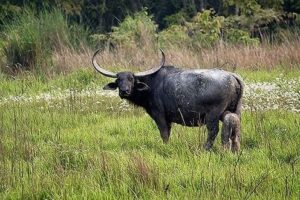LIVESTOCK NATURAL FARMING IN NORTH EAST INDIA
ABSTRACT:
In this article I have written about the Livestock natural farming and its importance in North East India , As the farming sector is the backbone of our country and its is the prime responsibility and a student related to farming sector. Natural farming comes under very important and beneficial type of farming in our country. Through this article I would like to share the information through which farmers are using this method to rare the animal.
INTRODUCTION:
The rugged and pristine landscapes of North East India are not only home to diverse flora and fauna but also to unique livestock species that have shaped the region’s cultural, economic, and ecological tapestry. Among these Yak, Mithun, and Buffalo stand out as iconic symbols of resilience, adaptation, and symbiosis with nature. Natural farming practices that have been honed over centuries by indigenous communities sustain these invaluable livestock species, ensuring their well-being while harnessing their diverse products for the sustenance of local livelihoods. The products derived from yaks, mithun, and buffaloes, including meat, milk, fiber, and hides, play vital roles in the culinary traditions, cultural rituals, and economic activities of North East India.
Difference between Natural farming and Organic farming(Table1)
| Aspect | Organic livestock farming | Natural livestock farming |
| Definition | Farming system that emphasizes the use of organic feed, restricts the use of synthetic chemicals, antibiotics, and hormones, and promotes animal welfare and environmental sustainability. | Farming system that allows animals to graze on natural pastures and feeds, may restrict the use of antibiotics and hormones, but doesn’t necessarily follow strict organic regulations. |
| Feed | Emphasizes organic feed (certified organic grains, forage, and supplements). | Allows animals to consume natural forage and may include some organic feed but may not be exclusively organic. |
| Antibiotics and Hormones | Prohibits the use of synthetic antibiotics and hormones, except in cases of illness. | May limit the use of antibiotics and hormones but doesn’t strictly prohibit them |
| Pasture and Grazing | Emphasizes access to pasture for animals, with specific requirements for outdoor access and grazing periods. | Allows animals to graze freely on natural pastures, but may not have stringent requirements for outdoor access or grazing periods |
| Pest Control | Emphasizes natural pest control methods and prohibits the use of synthetic pesticides | May use natural pest control methods but might also use synthetic pesticides if necessary. |
Natural Farming of Buffaloes in Assam
Natural farming of buffalo in Assam embraces traditional methods, integrating the animal into the local ecosystem. Buffaloes are crucial in Assam, providing milk, manure, and labour. Typically reared in small herds, they graze on diverse grasses, weeds, and crop residues, promoting soil health through natural fertilization. Assamese farmers often incorporate traditional practices like ‘community grazing,’ where buffaloes graze collectively, benefiting from each other’s presence.
Indigenous breed of buffalo of Assam is Luit . Luit buffalo is predominantly swamp-type buffalo breed. It is an integral part of Assamese society and has an ample ability to survive under a low-maintenance system.
Buffalo milk is highly valued in Assamese cuisine for its richness, creaminess, and distinct flavor. It is used to prepare a wide range of traditional dishes, including curries, sweets, and beverages. Additionally, buffalo milk is processed into various dairy products such as ghee, paneer (cottage cheese), and Doi (yogurt), which are staple ingredients in Assamese households.
Natural Farming of Mithun in North East India
Natural farming of Mithun, a semi-domesticated bovine species, in Northeast India is a traditional and sustainable practice deeply rooted in the region’s culture. Mithuns are reared by several indigenous communities such as the Nagas, Mizos, and Arunachalis for their cultural significance and economic value.
In natural farming, Mithuns are allowed to graze freely in the forests, feeding on a variety of natural vegetation. This not only ensures their well-being but also helps in maintaining the ecological balance of the forests. Additionally, Mithun dung is rich in nutrients, which enhances soil fertility and promotes the growth of natural vegetation.
This form of farming also plays a crucial role in the conservation of Mithun populations, which are considered a vulnerable species. By integrating Mithun rearing into their traditional farming practices, communities in Northeast India are not only preserving their cultural heritage but also contributing to the sustainable management of their natural resources.
Natural Farming of Yaks in North East India
Natural farming of yaks in Northeast India is a traditional practice deeply intertwined with the region’s cultural heritage and environmental sustainability. Yaks, well-adapted to the harsh mountainous terrain and cold climate, are primarily raised by indigenous communities like the Brokpas, Sherdukpens, and Monpas.
In natural farming, yaks graze on natural pastures rich in medicinal herbs, which not only provide essential nutrients but also contribute to the unique flavor of yak milk and meat. This method minimizes the use of artificial inputs, making yak farming environmentally friendly and sustainable.
Yak farming also plays a crucial role in the livelihoods of local communities, providing them with a source of income, meat, milk, and fiber for clothing and shelter. However, challenges such as climate change, habitat loss, and limited market access pose threats to this traditional practice, highlighting the need for sustainable conservation efforts and support for yak farmers in the region.
Acknowledgement
I would like to thank Dr. Biju Borah and Lakhimpur college of veterinary science to give me the opportunity to explore this topic. I would also like to thank my Father to give me some knowledge about the natural farming .
Writer:
Sibom Kumar Shil
Third professional year, BVSc & AH
Lakhimpur college of veterinary science
Joyhing, North Lakhimpur,787051
References:






